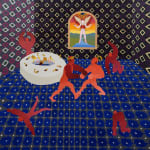Open a larger version of the following image in a popup:
 Photgraphed by Lukas Mykolaitis
Photgraphed by Lukas Mykolaitis
 Photgraphed by Lukas Mykolaitis
Photgraphed by Lukas Mykolaitis
Open a larger version of the following image in a popup:
 Photgraphed by Lukas Mykolaitis
Photgraphed by Lukas Mykolaitis
 Photgraphed by Lukas Mykolaitis
Photgraphed by Lukas Mykolaitis
Open a larger version of the following image in a popup:
 Photgraphed by Lukas Mykolaitis
Photgraphed by Lukas Mykolaitis
 Photgraphed by Lukas Mykolaitis
Photgraphed by Lukas Mykolaitis
Open a larger version of the following image in a popup:
 Photgraphed by Lukas Mykolaitis
Photgraphed by Lukas Mykolaitis
 Photgraphed by Lukas Mykolaitis
Photgraphed by Lukas Mykolaitis
Monika Radžiūnaitė Lithuanian, b. 1992
Vardan Dievo ir pelno / In nomine domini et proficuum / Viešpaties ir pirmagimio vardu | In the name of God and profit / In nomine domini et proficuum / In the name of the Lord and the firstborn, 2023
Aliejus ant drobės / Oil on canvas
120 x 120 x 2.5 cm
Further images
// EN \\ (for Lithuanian see bellow) Like the Jewish controversy over the Creator's intentions, the legends surrounding the Holy Grail seem endless. It is said to be the vessel...
// EN \\ (for Lithuanian see bellow)
Like the Jewish controversy over the Creator's intentions, the legends surrounding the Holy Grail seem endless. It is said to be the vessel on which Jesus Christ placed his lips at the Last Supper and whose blood was collected by the disciples after his crucifixion. Rumour has it that the intense search for it began with the Crusades, which led to the discovery of the Grail, now locked away under nine castles in the vaults of the Vatican or in a secret monastery of the Knights Templar in Malta. Others, who do not want to reveal their identity for security reasons, spread the information that it is not a vessel at all, but a stone that fell from space, that can cure all diseases and that has been in Atlantis for a long time. Still, others say that there is no mystery here - after all, it is in the Valencia Cathedral for everyone to see. And then there are those who lift the veil of mysticism and say that it is only a symbol, a sign of an impossible aspiration.
//LT\\
Kaip žydų ginčai apie Kūrėjo intencijas, taip ir legendos apie Šventąjį Gralį atrodo begalinės. Sakoma, kad tai indas, prie kurio Paskutinės vakarienės metu lūpas glaudė pats Jėzus Kristus, o jį nukryžiavus, mokiniai surinko jo kraujo. Gandai sklando, kad jo intensyvios paieškos prasidėjo su Kryžiaus žygiais, kurių dėka Gralis buvo rastas ir šiuo metu yra užrakintas po devyniais užraktais Vatikano lobynuose arba slaptame Maltos tamplierių ordino vienuolyne. Kiti, bijantys atskleisti savo tapatybę saugumo sumetimais, tekina nežemišką informaciją, kad tai visai ne indas, o iš kosmoso nukritęs akmuo, galintis išgydyti visas ligas ir ilgą laiką buvęs Atlantidoje. Dar kiti sako, kad jokios čia paslapties nėra - jis juk visiems prieinamas Valencijos katedroje. O yra ir tokių, kurie nutraukia visą misticizmo šydą, teigdami, kad tai juk tik simbolis - neįmanomos siekiamybės ženklas.
Like the Jewish controversy over the Creator's intentions, the legends surrounding the Holy Grail seem endless. It is said to be the vessel on which Jesus Christ placed his lips at the Last Supper and whose blood was collected by the disciples after his crucifixion. Rumour has it that the intense search for it began with the Crusades, which led to the discovery of the Grail, now locked away under nine castles in the vaults of the Vatican or in a secret monastery of the Knights Templar in Malta. Others, who do not want to reveal their identity for security reasons, spread the information that it is not a vessel at all, but a stone that fell from space, that can cure all diseases and that has been in Atlantis for a long time. Still, others say that there is no mystery here - after all, it is in the Valencia Cathedral for everyone to see. And then there are those who lift the veil of mysticism and say that it is only a symbol, a sign of an impossible aspiration.
//LT\\
Kaip žydų ginčai apie Kūrėjo intencijas, taip ir legendos apie Šventąjį Gralį atrodo begalinės. Sakoma, kad tai indas, prie kurio Paskutinės vakarienės metu lūpas glaudė pats Jėzus Kristus, o jį nukryžiavus, mokiniai surinko jo kraujo. Gandai sklando, kad jo intensyvios paieškos prasidėjo su Kryžiaus žygiais, kurių dėka Gralis buvo rastas ir šiuo metu yra užrakintas po devyniais užraktais Vatikano lobynuose arba slaptame Maltos tamplierių ordino vienuolyne. Kiti, bijantys atskleisti savo tapatybę saugumo sumetimais, tekina nežemišką informaciją, kad tai visai ne indas, o iš kosmoso nukritęs akmuo, galintis išgydyti visas ligas ir ilgą laiką buvęs Atlantidoje. Dar kiti sako, kad jokios čia paslapties nėra - jis juk visiems prieinamas Valencijos katedroje. O yra ir tokių, kurie nutraukia visą misticizmo šydą, teigdami, kad tai juk tik simbolis - neįmanomos siekiamybės ženklas.








